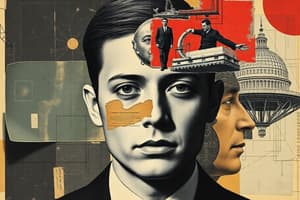Podcast
Questions and Answers
What is the main focus of the James-Lange theory of emotions?
What is the main focus of the James-Lange theory of emotions?
- Behavioral response leading to the feeling of emotion (correct)
- Simultaneous experience of emotional and physical responses
- Cognitive interpretation determining emotional state
- Experiencing emotions before physical reactions
In the Schachter & Singer experiment, why were subjects more likely to feel either happier or angrier based on their behavior?
In the Schachter & Singer experiment, why were subjects more likely to feel either happier or angrier based on their behavior?
- Because they were unaware of the reasons for their arousal (correct)
- Due to the unpredictable nature of their emotional responses
- Due to the unidirectional flow of emotions in the brain
- As a result of their deeply subcortical neural circuits
According to LeDoux, what is the primary difference between the Emotion Problem and the Emotion Solution?
According to LeDoux, what is the primary difference between the Emotion Problem and the Emotion Solution?
- The presence of innate emotional responses in cortical circuits
- The higher level state of emotions in neocortical systems
- The role of subcortical circuits in generating basic emotions (correct)
- The unidirectional nature of emotional states
In the context of Cannon-Bard theory, what does experiencing quadriplegia tell us about emotions?
In the context of Cannon-Bard theory, what does experiencing quadriplegia tell us about emotions?
What aspect of LeDoux's theory emphasizes that basic emotions are hardwired in subcortical circuits?
What aspect of LeDoux's theory emphasizes that basic emotions are hardwired in subcortical circuits?
Flashcards are hidden until you start studying




